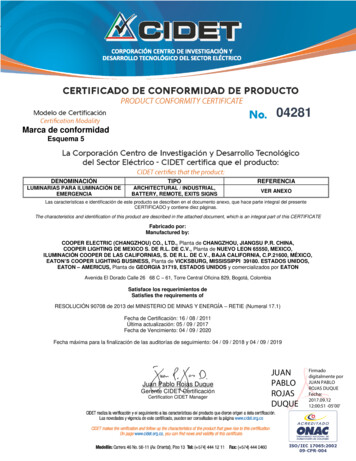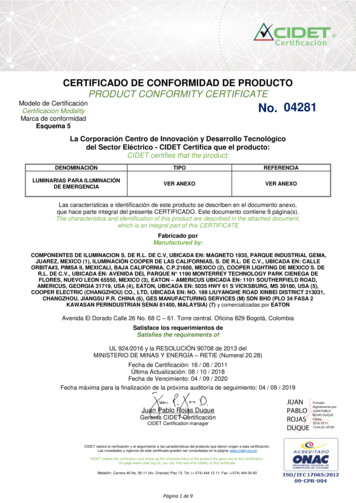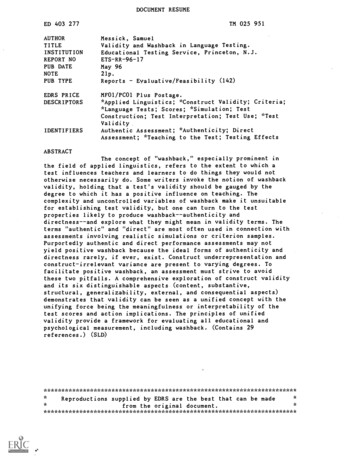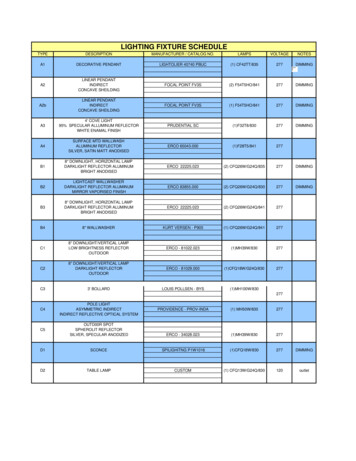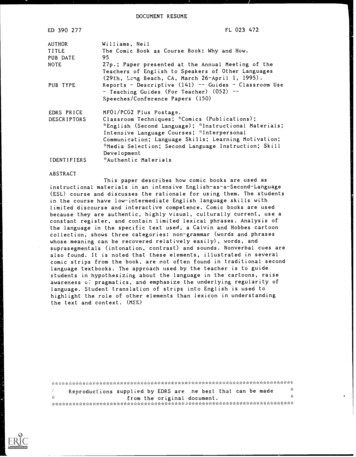
Transcription
DOCUMENT RESUMEFL 023 472ED 390 277AUTHORTITLEPUB DATENOTEPUB TYPEEDRS PRICEDESCRIPTORSIDENTIFIERSWilliams, NeilThe Comic Book as Course Book: Why and How.9527p.; Paper presented at the Annual Meeting of theTeachers of English to Speakers of Other Languages(29th, Lcng Beach, CA, March 26-April 1, 1995).GuidesClassroom UseDescriptive (141)Reports(052)Teaching Guides (For Teacher)Speeches/Conference Papers (150)MF01/PCO2 Plus Postage.Classroom Techniques; *Comics (Publications);*English (Second Language); *Instructional Materials;Intensive Language Courses; *InterpersonalCommunication; Language Skills; Learning Motivation;*Media Selection; Second Language Instruction; SkillDevelopment*Authentic MaterialsABSTRACTThis paper describes how comic books are used asinstructional materials in an intensive English-as-a-Second-Language(ESL) course and discusses the rationale for using them. The studentsin the course have low-intermediate English language skills withlimited discourse and interactive competence. Comic books are usedbecause they are authentic, highly visual, culturally current, use aconstant register, and contain limited lexical phrases. Analysis ofthe language in the specific text used, a Calvin and Hobbes cartooncollection, shows three categories: non-grammar (words and phraseswhose meaning can be recovered relatively easily), words, andsuprasegmentals (intonation, contrast) and sounds. Nonverbal cues arealso found. It is noted that these elements, illustrated in severalcomic strips from the book, are not often found in traditional secondlanguage textbooks. The approach used by the teacher is to guidestudents in hypothesizing about the language in the cartoons, raiseawareness c.)- pragmatics, and emphasize the underlying regularity oflanguage. Student translation of strips into English is used tohighlight the role of other elements than lexicon in understandingthe text and context. (MSE)ne best that can be madeReproductions supplied by EDRS arefrom the original document.*1***
Presented at the 29th AnnualTESOL ConventionLong Beach, CANcil WilliamsAmerican Language InstituteNew York UniversityMarch 28April 1, 1995THE COMIC BOOK AS COURSE BOOK: WHY AND HOWThis paper will describe how a comic book has been used in class to raise studentawareness of certain aspects of applied linguistic theory which arc often ignored in traditionalESL course books (c.g interactional aspects of spoken language (Brown and Yule, 1983) orlexical phrases (Lewis, 1993, Nattinger and DeCarrico, 1992).The comic book is used in a very specific cc,ntext:a) in an INTENSIVE program; classes meet 20 hours a week,I)) in a course where use of the comic book is complementary to other teaching, nota substitute for it (though many exercises arc based on the description of language gleanedfrom the comic book); andc) with students (officially classified as 'low intermediate') who already have notionsof English; they have already studied it at school in their home country, typically for six orseven years. They can and do score very high on multiple choice grammar tests, and can anddo quote grammar rules verbatim in Ll. Their discourse/interactive skills, however, arcrudimentary at best; whenever thcy speak (IF they speak at all) they arc unable to string morethan three English words together without using a dictionary. We might say these studentshave 'plateaued', since their major complaint seems to he that they arc always studying the,,,same thing in their classes, over and over and over.ABEST COPY AVAILABLE2I.(4!, OEI-N Gf-I AsN' TEDN'('ATIINI-c,10.14')NI ') All ll4IB41 ;FIF5,(MH(21-5NTF ft a F-0(0I!If li!-f'()IiMATION
Why the comic book as course book?So why use a comic book as a course book? First and foremost, the comic book used(the Calvin and Hobbes collection, Yukon Ho! by Bill Watterson) is AUTHENTIC English,written for Englishspeaking Americans, rather than doctored for ESL students. As such itis a true TEXT book (or a book of texts, if you will). As they read it students are exposedto English as a WHOLE, and not the simplified collection of structures presented in a linearfashion which is the staple of most ESL course books.Furthermore, this comic book(roughly 16,131 words, in 1380 frames in 285 strips) is a far richcr resource for these ESLstudents than other sources of authentic English, such as novels, newspapers or film (eitheras a dialogue or as a script). To explain why this should be so, it becomes necessary to lookat the attributes of comic books:WHY?VISUALHERE AND NOWCONSTANT REGISTERLIMITED LEXICAL PHRASESFigure 1. Why the comic book.First, cartoons have a permanent, visual component (unlike movies, which arc visual2
but timebound (language is only caught fleetingly as the action progresses); or dialogue,which is permanent, but not visual). Characters interact in a here and now (you and me notthc him and her of narrative), and share many of the paralinguistic aspects of interactioni-riuch of what thc characters arc saying can be inferred from expressions on faces, or fromposture).Next, comic book language lies about halfway between real spoken English and"written" English. While it is missing much of the pause phenomena, false starts, overlappingand whatever of unrehearsed speech, it DOES reflect real people speaking real English, andcontains frequent examples of 'interactional language' (after Brown & Yule, 1983; this termwill be explained later).Third, within this language, there is a continuity of register through the fact that thccharacters arc always the same, and always in thc same social context with regard topower/intimacy relations. (In Yukon Ho! there are no more than 5 regular characters:parents, their son, the son's best friend (who's imaginary), and the girl next door).Fourth, and finally, the language represents one man's idiolect ( that of Bill Watterson,the writer) and so is rich in fixed collocations (limited to one man's experience of the world,so limited enough for students to be able to handle), which come round again and again indifferent contexts.The comic book as a source of interactional language.Brown and Yule (1983) divide language into two functional categories:34
That function which language serves in the expression of 'content' we willdescribe as transaztional, and that function involved in expressing socialrelations and personal attitudes we will describe as interactional. (p.1, originalemphasis).Although some of what Brown and Yule term interactional language IS presented in ESLcourse books, albeit in a cursory way (e.g. as formal/informal expressions of certain language"functions"), much of what characterizes spoken discourse is left out of them, (as indeed,much is omitted from Brown and Yule's description of discourse).This, of course, isbecause, to date, no adequate description of everything we do when we talk has yet beenclatorated, a point made in Brazil, 1995: "le]xisting definitive grammars do not explaineverything.uncertainty [is] a fact of the linguist's life" (p.1)What follows is a subjective list of some aspects of spoken discourse, and a description ofhow the comic book is a useful avenue to lead students to explore them. This list is presentedin tabular form in figure 2Categorizing the language of Calvin and Hobbes.Figure 2. about here(CATEGORIES) IA: "Non Grammar"The first category of aspects in thc list is of 'ungrammatical' expressions where the originalformal grammatical meaning can be recovered fairly easily. These fall into two groups:1) what wc might call LOOSE REFERENCE:45where cohesive tics (Halliday and
Language CategoriesA:"Non-Grammar"- [4- recoverable meaning]"Loose reference": mandibles of death, that's what he's got It works much better with a twenty ; that'sit. I Isn't it cute how.Ellipsis: See the jets? Hard to believe. What's it look like? ; Care to repeat.? Beats me.Girls are like slugs. They probably serve some purpose, but it's hard to imagine what.Blends: Gotcha. Outta my WAY! ; Leggo. I dunno.Mitigators: I guess. I Maybe. ., maybe. ; . kind of . . sort of. ; ol' noun (?)Comments: Wow! I Boy! Oh boy! ; Oh brother. Geez,. ; Rats.; Phooey. I [BELIEVE IT ?IN'T]Opinions: I think. I take it. [personfd better. It's about time.Lexical phrases: I'll say. What do you say? I take it."Synonyms": How come.Iwhy.Iwhat . for? Suppose.Isay.1what if.? ; yeah,Iyup.lyou bet!Intensifiers, real [ adj] I sure f verbl I heck! I get [PREPP(Cf [ACTION VERB] [PREP]!)B:"Words"Lcxis [general]Verbs: LET/GET/MAKE/TURN/DO/BE/HAVEParticles and Prepositions: UP/1N/OFF/THROUGHNouns: acci '-nt I turn of eventsLexis [vague]stuff .and stuff .or something. . and everything. thelthis (*) thing the (whole) * bit.(atthat's it! that's it. ; that's good. that's a relief ; the * incident the * affair ., you KNOWend of turn)Lexis [empty]"Doing words": Oh. ; Well,. ; So,. ; How about.? I., then. ;You know,.See,.; Say,. ; I tnean,.Confirmation check:propositional contcnt: (is that/am I) right? What Mom and Dad don't know won't hureem, right?speech act: OK?/(all) right? No more monkey business, right?context/inference: [tag]/huh? Kid watches a lot of TV does he? ; Pretty scary, huh?negative questions:Why *n't .? : Why aren't you at work?*n't .?: Aren't you excited to see Uncle Max?C:Beyond Words:Intonation : Oh No! It's ROSALYN! OUR BABY SITTER?! ( paroling); Gosh Dad, ( paroling)Contrastive stress: this is MY room 0ii Geez, RUN!! ; suppose some kid TRIED to be good,.Sounds: THBBPTHBPT! Uh-oh. ; mhm hmmm AAUGH!! T4 -DAA! GLOMP!Figure 2. Categorizing the language of Calvin & Hobbes
I'M GOING 114PAPr4 YOIJRWAAGE. VINATS it 'LeetU. rm DOWDID SOW AM QM RAISE10u ltasae, (RN IleAnt UWE tuv Isvr ?pcets icymw It ARESEW ?CWIolEelutE IT VtiuticLE KM, La 3K!SAN OU mA6K.P1941913,alti6 112c0.!Um in Ct:vet, RID Coavivc tsA trits-whITWELL IOU KMnos win?81A.B.CALVIN AND HOBBES C Watterson. Reprinted with permission of UNIVERSAL PRESS SYNDICATE. All nghts reservedFigure 3. Max
Hasan, 1976), such as it, this or that don't refer as strictly as they should and2) ELLIPSIS and BLENDS.[Figure 3. here (Max)]At a loose reference level, in this set of strips it refers to 'nothing': What's it look likeI'm doing (Strip 2/ Frame 3); or to a distant referent: No it works much better with a twenty(it 'the trick'), Strip 3/Frame 3; and that's what 'ungrammatically' refers to mandibles ofdeath (Strip 1/ Frame 2).Similarly we have the ellipted forms: Nice room. (for Kat a nice room!) in Strip 1/Frame 1 and What's it look like I'm doing? (for What does it look like I'm doing?) in Strip2/ Frame 2. This, incidentally, gives students a great dcal of trouble, because they expect isor has to be the ellipted form based on what they have been taught to expect whenencountering s.And then there arc blended forms: Gotcha.( I got your drift) in Strip 1/ Framel. Youwill also encounter Outta my WAY! ,( Get out of my WAY!) and Leggo ( Let go) in the nextset of strips.At a second level, there are expressions where what can he recovered expresses anattitude, positioning the speaker vis-à-vis what s/he is saying'. These arc marked [ I]in Figure 2.5
masY OUR Bartwi FACT, A.F1S The LCAA,NE OMERLEN'S GEra we 4-04ER EntantkitCAR MAD LEARNT comING uP!Ctk Ere IEr IDGNE NNE.SAE.MIK 41652.bAt WAM ANDte:)onr&SALM!Qua, 'ALDE!!TitEr uSlees, e4.1111NV%ZST,.000fallAMI O&M 1041C3k 43t)AND WATS WAT DA easea3 t. tve4w t memsm.* 133 TO k.All nghts reservedCALVIN AND HOBBES C Watterson. Reprinted with permission of UNIVERSAL PRESS SYNDICATE.Figure 4. Rosalyn
S3 WI AQEvArkIS14e4 114EREST54WE?,.katE? WI ARD41'AN AT 'WM?I 103K I%DA-1 CC.-AS MC%SAM, DAD, C.M440.1 CDAAE ICANE. STILL.I IAPIS A ICOKAS INAT IVECIRACIED1100101VIII4 T. MK ?4.:c.--.- -.,ei rita--4 4 ' 63,BORROW iI.AT %MOH RAWNIS WPM.WI CCICTIOU REPOiy.41417.,-GOSIOAD I'D 3.% LAKE M'WE UMW?DV 44-Iz"1/ 42*.'KEN DAD I104AED.Flrai341 MPSELM NERKED.u8Six. qiemScs4 Dt5citkiNEk 14USC. ASY- RIC./4.41,1 OlatiG .IciNAL AU Us4.CALVIN AND HOBBES Watterson. Reprmted with permission of UNIVERSAL PRESS SYNDICATE. All rights reservedFigure 5. Dad
I 010tAt IIAINK IT 141) KENSr3 t.C14, UNTIL I 941NIS GO I4PSREA/13 GRCANoe-SJD. WAT COIN SM?CALVIN AND HOBBES C WattersonReprinted with perraismon of UNIVERSAL PRESS SYNDICATE.Figure 6. Max AgainiiAll tights reserved
[Figure 4. here (Rosalyn)]These arc:Mitigators:implying that the speaker is only partially committed to thc truth ofwhat s/he 's saying: I guess (but I could be wrong.) Strip 1/ Frame 1Comments:Reactions to a situation, ranging from general, strong surprise (GEEZ!!Strip 2/ Frame 4), through glee: (Oh Boy!dismay (.0h Brother.Strip 1 / Frame 3), toStrip 2/ Frame 2 : note the intonation curves),passing through unhappy surprise (Oh No!disgusted frustration (Phooey.Strip 1/ Frame 4) toStrip 3/ Frame 1).[Figure 5. here (Dad)]Opinioi ;:Strongly held; not necessarily true, but definitely held to be so. I takeit there's no qualifying exam. (Strip 1/ Frame 4)'Synonyms':How come? and Why? differ in the amount of surprise in the context.In strip 1 / Frames 1 & 2, How come? marks the surprise in frame 1,while why? continues the interrogation in frame 2. Elsewhere in thebook yeah, yup, and you bet! vary in thc intensity of thc agreement,while Heck no!, Forget it! and No way! imply different kinds of "NO!"(as a friend of mine put it, "These arc afl no with an attitude!")[Figure 6. here (Max again)]6
Lexical Phrases:(Nattinger and De Carrico, 1992.) In Strip 1/ Frame 1, It's great to seeyou, Max! and It seems like ages since you've been here, as well as I'llsay, and What do you say?arc examples of sentences which areroutinely said thousands of times in the same situation In fact most ofFigure 6 is a routine (a ritual, even) rathcr than an information exchange(which is what makes Calvin's reply so surreal.)B: "Words"The second major category of speech phenomena has do to with words, rathcr than text.First, there is a great deal of General lexis usc in spoken discourse. General lexemes,(primarily verbs, Jr a verbal context) are relatively few in number, have an abstract meaning,and so allow the listener considerable latitude for interpretation according to context.2Probably the easiest example to illustrate this kind of lexis is the verb [GET]. IGETj has abasic, abstract meaning of: Somebody [DO] something, and as a result there [BE] a newstate. Other general lexemes include [LET], /TURN], [MAKE], [TAKE!, and [UP], [OUTP.One step beyond general lexis comes vague lexis (Channell (1994): words like stuffl ., andstufflthe thing! non-referential thatlthe * incidenefinal position you know,words whichprovide the listener with the opportunity to provide or complete meaning in the given context(no latitude of interpretation here; the listener is to provide all the information the speakerwants inferred).7
040 APPOKTD WM? MNIn 4, ' Kw ALS 1442114.!litur c.R Tao. DIS 4. QSE.Fcg DETalatvirAG cd3Z0AND IN) ?Figure 7. Christmas14
[Figure 7 here. (Christmas)]In these Christmas strips, the Santa Claus stuff is never made explicit, while the salamanderincident is never described4. Given the context, the reader is expected to provide all thedetails. Hence the humor, given what the reader knows about Calvin and his capacity formischief. Students invariably do not understand how far THEY must provide the details, andfail to see anything funny until this is made explicit to them.All of these lexical forms go hand in hand with Graphic conventions (underlining,heavier/larger letters) which illustrate how word stress is often used for contrast. Again,students have a really hard timc dealing with this aspect of the text. They are so fixated onthe words, that stress goes right by them.Finally, even lower down the meaning scale, comes "empty" lexis: words used for "doingEnglish", (signals about how what is to come or what has been said arc to be interpreted). Forexample, in Figure 6. (Max again), Strip 1/ Frame 3, So, marks the following utterance asoffering a new topic. This usc of language has been described by Blakemore (1987), andespecially by Schiffrin (1987), who describes such discourse markers as the contextualcoordinates of talk. Other words that function this way: well, I mean, you know.C: "NonwordsThe final aspect of spoken language which is given scant or no place in ESL course booksis the use of nonwords which carry meaning purely through intonation and/or bodylanguage, words such as uhhuh, lunph, mhm, augh!, and8
Figure 8. THBBPTHBPT!lo
(Figure 8. here. (TEMPTHPT!!)]Teaching with the comic book.A caveat and a definition.The previous section described in a rathcr cursory way, some of the aspects of spokendiscourse which arc rarely treated in mainstream ESL text books. Some of theses aspectshave been documented by applied linguists, in greater or lesser detail (and have been creditedas such), while othcrs arc my own intuitive groupings gleaned from a fiveyear continuedstudy of a small corpus of Calvin & Hobbes comic books'. I would not go so far as to claimthat the aspects I have described arc anything more than one way, one of many ways, indeed,of describing spoken English. I WOULD, however, claim that such a description has greatpedagogical merit as it provides a principled starting point from which to help students to seeEnglish differently, and so start building a PERSONAL grammar. This cursory skeleton ofan 'alternative' grammar is essentially a protogrammar, a grammar that goes beyond thc welldocumented list of structures the student has learned, into the rather murkier areas ofinteraction, which the student has never considered. It is a protogrammar, because, althoughexplicit, (at least in the first stages) it presents students with categories that are permanentlyprovisionalit seeks to encourage uncertainty and flexibility rather than certainty and rules.Indeed, as new facts are introduced from thc language data (in this case, the comic book), itdoesn't take long for students to start challenging, adapting or collapsing these categories intocategories which arc more meaningful for them, ordering this authcntic English, not only bySTRUCTURE ("grammar"), but also by EFFECT (a pragmatic grammar).91 *i
MethodologyIn the context of the protogrammar it becomes clear that what is important is not so muchgetting language into students' heads, hut rather getting them to learn how to look at it andclassify it for themselves. Michael Lewis (1993) describes a learning situation which informsmuch of what I do in class. He writes:True learning seems to result from a continuous symbiotic relationship betweeneverience, reflection on that experience, and eventual holistic internalization of it.Learning is essentially provisional and cyclical, based on endlessly repeating the cycleObserve (0)Hypothesise (H)Everiment (E).(p. 55-56 emphasis added)This is shown in figure re 9. 0H(E)--E (after Lewis, 1993)Notice the fourth step, which students have found necessary, that of evaluating thc results ofthe experiment before going on to begin thc cycle again.1018
Needless to say this is quite different from the systcm my students are used to. In that system,a teacher presents a structure (a bit of language) which students then practice btforemoving on to full production of that bit. The cycle repeats itself with new bits of languagebeing fed to the students in a linear fashion. As I said earlier, my students are alreadyfamiliar with that. They can quote the rules and do the sentence combining with facility, butthey still struggle with text in English. Through Yukon Ho!, they are offered an alternativeto complement what they have already acquired. Much of the methodology capitalizes on thefact that the text is both authentic and extended.[Figure 10. around here. (Teaching the lang of C&H)1First and foremost, the key to using Calvin and Hobbes has been REGULARITY. Sincethe language is authcntic, it is not a sequential accretion of structures; students need to beexposed to it as much as possible, so as to become aware of the underlying regularities in it.The morc students see of the text, the more familiar those regularities become. The teacher'srole in this has been to raise and maintain awareness of pragmatic forms, first by prcsentationof 'other' categories, (if you don't recognize that there is something else, how can you hopeto see it?) and later by intensive questioning, to keep students refining and redefining whatthey are looking at. At a later stage, tcwards the end of the semester, thc students arc askingthe questions for themselves; the learning is no longer in my hands.[Figure 11. about here (Far from home)]11
Teaching with the comic book.1.REGULARITY.Language is authentic, not sequentially graded; students need frequent exposure to appreciatethe repetitious nature of the language. The more students see the text, thc more familiar theunderlying regularities become.2.AWARENESS RAISING AND MAINTENANCE, rather than TEACHING. (Lewis2a.TRANSLATION OF EFFECT:OHE).Teacher role: initial presentation of concepts rather than form, followed by intensivequestioning to elicit forms that fit concepts. Class heuristics. Going through the wordsto the language.By puzzling out the effect of a lexical string, students are searching for coordinates fora pragmatic mapping of L2 on Li.Teacher's role: Pragmatic questioner:WHY does the character say X, rather than WHAT does X mean? (tying theutterance to the context)What is the character thinking? (focus on paralinguistics) How will thiswords?affect the way slhe says theHow is this said? (emotional/contrastive stress markers)What's the opposite of what slhe is saying? (opposite effect). I guess[NPHBEliadj] vs [NP][BE] SO [adj]What's the new state after get?Why Oh,. and not Well,.?Why are prepositions there? (why eat up, and not just eat?)Is this language usefullnot useful?generative power (Lewis)high generative power vs lowWhat's another way to say that? How would that change what slhe says?2b.THE HABIT SETS IN.3.RECYCLE, REFLECT, RE-EVALUATE.Questions & translation keep the pragmatic aspects of language in the mind. Over time, thehabit sets in; language is not so much presented and represented as recycled subconsciously.Constant (guided) Observation, leads to articulated Hypothesis and Evaluation. Students makemeaning.Grids and exercise types to recycle language.: periodically, students complete them to updatetheir grammars as thcy come across new examples or exceptions.Figure 10. Teaching the language of Calvin & Hobbes
Far From HomeA:B:A:B:A:A:B:A:13:A:B:A:B:A:B:A:Scusi, signor uhmin this chair free?Sure. Go right ahead.Well, I'll be. You're AMERICAN!That's right, from New York. Bill Johnson.Fred Levy. Wow! Am I PLEASED to see YOU! It's good to hear an American accent for a change.Yeah; and don't I know it! Would you like to sit down awhile?Thanks, that'd be great.So Bill, what brings YOU to Santa Flora?Business. I sell ears over here. How about YOU?I'm at a conference here, you know, over at the Gran' Palazzo.Oh. Right! Isn't that the ASFP conference?You got it! And, can you believe it, I'm the only English speaker there!Really? that must be difficult. Oh. Would you like a drink?Thanks. Do they have beer? That'd be great.So you're alone here, then?Well, actually I'm NOT. My secretary's here, too, but she's******* ***** *****.**************************A:Scusi, signor uhmm this chair free?ahead.GoB:A:,I'll be! You're AMERICAN!13:That's right, from New York. 13111 Johnson.A:Fred Levy.PLEASED to see YOU! It's good to hear an American accent for a change.I know it! Would you like to sit down awhile?A:13:A:B:Thanks,'be great.13ill, what brings YOU to Santa Flora?YOU?Business. I sell cars over here.conference here;13:Right!'that the ASFP conference?, can you believe it, I'm the only English speaker there!A.Would you like a drink?13:Really? that must be difficult.A:Thanks. Do they have beer? That'd be great.13:, over at the Gran' Palazzo.you're alone here,I'm NOT My secretary's here, too, but she'sFigure 11. Far from home.
Early in thc semester, students arc given the dictation: Far from Home, (Figure 11), normalspeed, blends, ellipsis and all. After the dictation, students are given the text, and asked tocomment on why some words are in capitals. From this step (introduction of stress as amessage carrier), it's a (fairly) simple step to consider the functions of: So, Wow!, Can youbelieve it? and am I PLEASED to see YOU! Words and expressions are then entered into the"Doing Words" sheet (Figure 12.)[Figure 12. about here (Doing Words)]Homework is then a translation of thc first six strips in Yukon Ho!. Generally, the nextmorning, students are dispirited, as they realize the difficulty of doing what had always beeneasy for them; when they translate the words, they still can't make sense of what is being saidby the characters. At this point students are made aware that translation of Calvin andHobbes is not so much a translation of "meaning" hut of effect (Why form X, and not formY, rather than What does X mean?)About this time we throw out the bilingual dictionary, and start worling with a corpusbased English dictionary of synonyms; The Longman Language Activator. (It's the only oneof its kind that I know of for ESL students, but be wary. It's big, confusing can be frustratingto work with at times) Every night from then on, students translate two or three pages of text(an average of 100-150 words) into LI. Why translate? Two reasons;a) students will do it anywaywhy not capitalize on a strategy they are already using?12
"DOING" ION4:10y5:DISALI !Eh6:ACICNOALI-DGE NEWSSIGNALS:1:NEW TOPICOFFER2:WW1-ATMs TO TOPIC3:TOPIC TAKOVER4:CONTINUE TOPIC5:RF.TURN TO TOPIC6:RECAP TOPIC7:LISTLN TO TinsCONFIRKATION CHECKS:1:WORDS2.ACCION-A:CONTEXT4:"1 'rum"Figure 12. Doing Words:4;
and, far more importantly,b) by puzzling out the effect of a lexical string, students are having to search for apragmatic mapping of Ll on L2. All problematic language is discussed and elaboratedupon the following morning in class. Often one student will disagree with another student'stranslation where no such translation exists in the bilingual dictionary, which further refinesthe pragmatic mapping process. The teacher's job is to keep asking the difficult questions:not WHAT does X mean?, but rather WHY did the character say it? or What would asimilar character say in a similar context in your country?Other useful close question types arc:Is the word usefullnot useful? (Lewis sets up the distinction between lexis with highgenerative power and collocational range, and lexis with high information and lowgenerative power or collocational range. Haemoglobin, or Down in the Dumps arc muchless useful to students than getl or be in the way )What is the character thinking? (look at the paralinguistics), and will this affect the ways/he says the words? (e.g. [Figure 5. Strip 2/ Frame 2j Say, Dad.)How is this said? (look at stress markers and capitalized words)What's the opposite of what slhe is saying? (the opposite of I guess is.?)- What's the new state after get?Why Oh, and not Well,?Why hmph and not sheesh?What do the prepositions mean? (cg why eat up , and not just eat?)What's another way to say that? How does that change the meaning? (e.g What happens13
to the effect of the question, if you replace what if with say. or supposing.?)All these questions keep the pragmatic aspects of the language in the students' mind as theytranslate regularly. Over time, thc habit sets in, and they ask themselves the questionssubconsciously. It's not so much the presentation or practice of bits of language as much asthe increasing familiarity with ALL of the language, a constant cycle of Observation,Hypothesis, Experimentation, Evaluation, Observation, Hypothesis, Experimentation and RE-evaluation (how have the rules I've been operating under hold up to the new data?)In this paper, I have attempted to show one way of helping students gain a pragmaticawareness of English.It is not THE method for teaching English, nor is it a peripheralapproach to teaching English. It is a principled approach to raising students' awareness tomuch of thc ambiguity, vagueness and downright sloppiness of spoken English. Rather thanpresenting this as something to be deplored and eradicated, I have proposed a route by whichstudents can begin to make sense of what surrounds them in the streets, and as they gainpersonal insights to make tentative hypotheses about how they can begin to profit from anduse that sloppiness. As they progress through the institute and come in contact with more andmore English, students invariably tell me that they continue to ask the same questions T. forcedon them when they were with me. In short, they have become more active languagelearners, rather than students waiting to be taught. Isn't this what learning is all about?14
REFERENCESBlakernorc, D. (1987) Semantic constraints on relevance. Oxford:Basil BlackwellBrown, G. & Yule, G. (1983). Discourse analysis. Cambridge: Cambridge University Press.Channcll, J. (1994). Vogue language. Oxford: Oxford University Press.Halliday, M.A.K. & Hasan, R. (1976) Cohesion in English. New York: Longman.Lewis, M. (1993). The lexical approach: The state of ELT and a way forward. Hove, UK:Language Teaching Publications.Lakoff, G. and Johnson, M. (1980). Metaphors we live by. Chicago: University of ChicagoPress.Longman language activator. (1993). Harlow, UK: Longman Group UK. Ltd.Nattingcr, J.R., & De Carrico, J.S. (1992). Lexical phrases and language teaching. Oxford: OxfordUniversity Press.Perkins, M.R. (1983) Modal expressions in English. London: Frances PinterSchiffrin, D. (1987). Disc
limited discourse and interactive competence. Comic books are used because they are authentic, highly visual, culturally current, use a constant register, and contain limited lexical phrases. Analysis of the language in the specific text used, a Calvin and Hobbes cartoon collection, shows three categories: non-grammar (words and phrases


